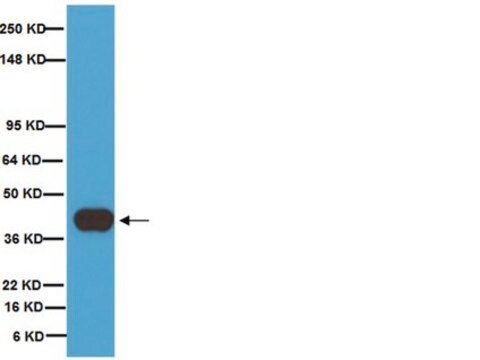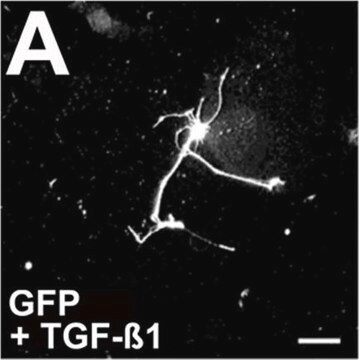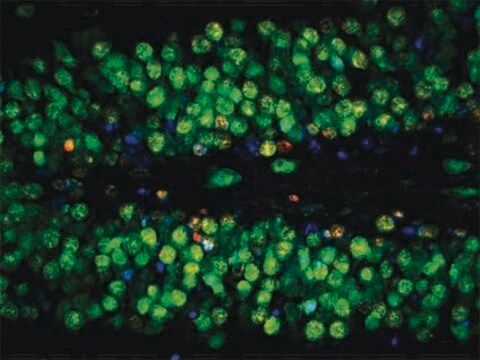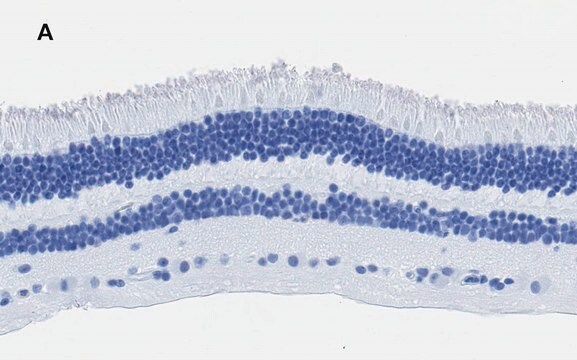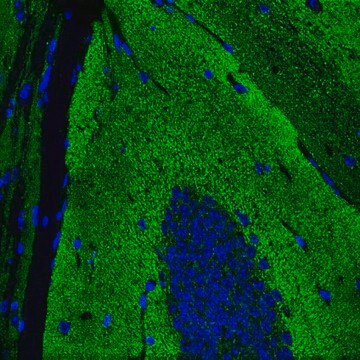CBL212
Anti-Neurofilament 200 kDa Antibody, clone RT97
clone RT97, Chemicon®, from mouse
Autenticatiper visualizzare i prezzi riservati alla tua organizzazione & contrattuali
About This Item
Codice UNSPSC:
12352203
eCl@ss:
32160702
NACRES:
NA.41
Prodotti consigliati
Origine biologica
mouse
Livello qualitativo
Forma dell’anticorpo
purified antibody
Clone
RT97, monoclonal
Reattività contro le specie
rat, human, pig, avian, chicken, reptile
Reattività contro le specie (prevista in base all’omologia)
mammals
Produttore/marchio commerciale
Chemicon®
tecniche
immunohistochemistry (formalin-fixed, paraffin-embedded sections): suitable
Isotipo
IgG1
N° accesso NCBI
N° accesso UniProt
Condizioni di spedizione
wet ice
Specificità
The clone RT97 recognizes the 200 kDa neurofilament polypeptide in a number of mammalian and avian species. Tumours specifically recognized include phaeochromocytoma, paraganglioma, ganglioneuroblastoma and other tumours of neuronal origin.
KNOWN SPECIES CROSS REACTIVITY: Recognizes rat, chicken, pig and reptile
KNOWN SPECIES CROSS REACTIVITY: Recognizes rat, chicken, pig and reptile
Applicazioni
Anti-Neurofilament 200 kDa Antibody, clone RT97 detects level of Neurofilament 200 kDa & has been published & validated for use in IH, IH(P).
Research Category
Neuroscience
Neuroscience
Research Sub Category
Neurofilament & Neuron Metabolism
Neuronal & Glial Markers
Neurofilament & Neuron Metabolism
Neuronal & Glial Markers
Staining of both frozen and paraffin wax embedded tissue sections
Strong staining of neuronal processes in a variety of tissues
Optimal working dilutions must be determined by the end user.
Strong staining of neuronal processes in a variety of tissues
Optimal working dilutions must be determined by the end user.
Stato fisico
Format: Purified
The monoclonal is presented in phosphate buffered saline containing 10mM sodium azide and 1mg/ml bovine serum albumin. We recommend that each laboratory determine an optimum working titre for use in its particular application.
Stoccaggio e stabilità
Stable for 1 year at 2-8°C from date of receipt
Altre note
Concentration: Please refer to the Certificate of Analysis for the lot-specific concentration.
Note legali
CHEMICON is a registered trademark of Merck KGaA, Darmstadt, Germany
Esclusione di responsabilità
Unless otherwise stated in our catalog or other company documentation accompanying the product(s), our products are intended for research use only and are not to be used for any other purpose, which includes but is not limited to, unauthorized commercial uses, in vitro diagnostic uses, ex vivo or in vivo therapeutic uses or any type of consumption or application to humans or animals.
Raccomandato
N° Catalogo
Descrizione
Determinazione del prezzo
Codice della classe di stoccaggio
12 - Non Combustible Liquids
Classe di pericolosità dell'acqua (WGK)
WGK 2
Punto d’infiammabilità (°F)
Not applicable
Punto d’infiammabilità (°C)
Not applicable
Certificati d'analisi (COA)
Cerca il Certificati d'analisi (COA) digitando il numero di lotto/batch corrispondente. I numeri di lotto o di batch sono stampati sull'etichetta dei prodotti dopo la parola ‘Lotto’ o ‘Batch’.
Possiedi già questo prodotto?
I documenti relativi ai prodotti acquistati recentemente sono disponibili nell’Archivio dei documenti.
2-(Cyclohexylamino)-1-(4-cyclopentylpiperazin-1-yl)-2-methylpropan-1-one, a novel compound with neuroprotective and neurotrophic effects in vitro.
H Elbr?nd-Bek,A Wellejus,N M Kelly,M S Weidner,S H J?rgensen
Neurochemistry International null
Tissue engineering a complete vaginal replacement from a small biopsy of autologous tissue.
Roger E De Filippo,Roger E De Philippo,Colin E Bishop,Luiz Freitas Filho,James J Yoo,Anthony Atala
Transplantation null
Signals for the initiation and termination of synthesis of the viral strand of bacteriophage f1.
Dotto, G P, et al.
Cold Spring Harbor Symposia on Quantitative Biology, 47 Pt 2, 717-722 (1983)
Hisashi Hashimoto et al.
Neuro-degenerative diseases, 17(4-5), 181-198 (2017-05-11)
A novel ataxic mouse line was established from the offspring of a male mouse administered cyclophosphamide in a juvenile period. We have attempted to examine the phenotype and histopathological changes of affected mice. Furthermore, linkage analysis and sequencing of the
Iris Adam et al.
Current biology : CB, 31(14), 3115-3124 (2021-06-06)
The motor control resolution of any animal behavior is limited to the minimal force step available when activating muscles, which is set by the number and size distribution of motor units (MUs) and muscle-specific force. Birdsong is an excellent model
Il team dei nostri ricercatori vanta grande esperienza in tutte le aree della ricerca quali Life Science, scienza dei materiali, sintesi chimica, cromatografia, discipline analitiche, ecc..
Contatta l'Assistenza Tecnica.

